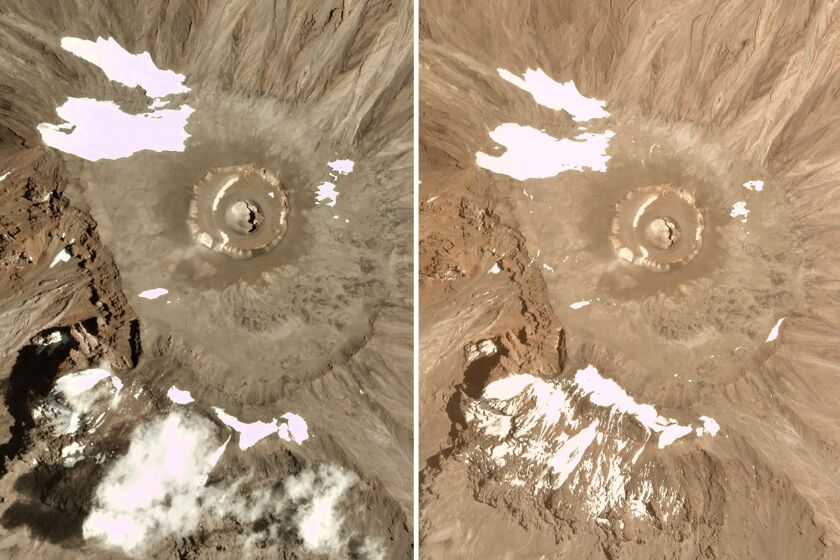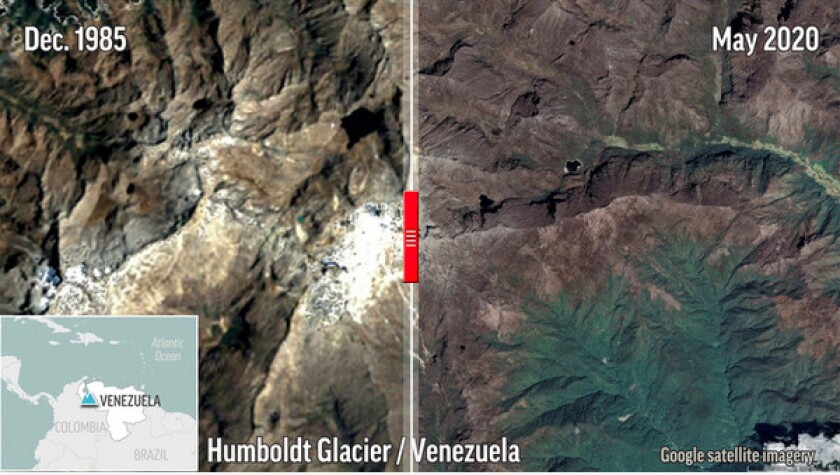JAKARTA, Indonesia — From the southern border of Germany to the highest peaks in Africa, glaciers have served as moneymaking tourist attractions, natural climate record-keepers for scientists and beacons of beliefs for indigenous groups.
With many glaciers rapidly melting because of climate change, the disappearance of the ice sheets is sure to deal a blow to countries and communities that have relied on them for generations — to make electricity, to draw visitors and to uphold ancient spiritual traditions.
The ice masses that formed over millennia from compacted snow have been melting since around the Industrial Revolution, a process that’s accelerated in recent years.
In Africa, the retreat can be seen on the border of Uganda and the Democratic Republic of the Congo, where the jagged Rwenzori Mountains jut into the sky above a jungle. The peaks once held more than 40 glaciers. Fewer than half remained by 2005. And the melting continues. Experts think the last of the mountains’ glaciers could disappear within 20 years.
The disappearance means trouble for land-locked Uganda, which gets nearly half of its power from hydroelectricity, including from power plants that rely on water flow from the Rwenzori glaciers.
“That hydroelectric power runs much better on more regular flows than it does peak and troughs,” said Richard Taylor, a hydrogeology professor at University College in London.
A continent away, on the southern edge of Germany’s border with Austria, only 124 acres of ice remains on five glaciers combined. Experts estimate that’s 88% less than what existed around 1850 and project that the remaining glaciers will melt in 10 to 15 years.
That’s bad news for a tourism industry that relies on the glaciers, said Christoph Mayer, a senior scientist in geodesy and glaciology at the Bavarian Academy of Sciences and Humanities in Munich.
“At the moment, tourist agencies can advertise, ‘You can visit some kind of the highest mountains in Germany with glaciers. You can walk on the glaciers,’ ” Mayer said. “People living around these regions really live from tourism.”
The same issue faces Tanzania, where experts estimate that Mount Kilimanjaro — the highest mountain in Africa and one of the country’s main tourism attractions — has lost about 90% of its glacial ice to melting and to sublimation, a process in which solid ice transitions directly to vapor without becoming a liquid first. Travel and tourism accounted for 10.7% of the country’s gross domestic product in 2019.
There are intangible losses for many indigenous communities that reside within sight of glaciers as well, said Rainer Prinz, a glaciologist at the University of Innsbruck in Austria.
In the history of the local populations, “The ice in the mountains is the seat of god. It has a very spiritual meaning,” he said, talking about communities near Mount Kilimanjaro. “Losing the glaciers there would also impact spiritual life, I think.”
The layers of ice that make up a glacier can be tens of thousands of years old and contain year-by-year information about past climate conditions, including atmospheric composition, temperature variations and types of vegetation that were present. Researchers take long tube-like ice cores from glaciers to “read” these layers.
During a 2010 research trip to the Carstensz glacier in Indonesia’s western Papua province, oceanographer Dwi Raden Susanto was excited to be part of a team that took a core sample from the remote glaciers. But once the sample was taken, Susanto said, scientists quickly realized the rapid decline of the ice allowed them to get records dating only to the 1960s.
“It is sad because it’s not only a loss of local or national heritage for Indonesia, but this is also the loss of climate heritage for the world,” Susanto said.
As glaciers vanish, experts say, ecosystems will begin to change as well — something already being studied at the Humboldt Glacier in Venezuela, which could disappear within two decades.
Experts warn that the fate of smaller glaciers offers a warning for bigger ones.
For example, while many of the world’s smaller glaciers no longer serve as the main freshwater source for countries, some larger glaciers do, as in Peru, which lost nearly 30% of its glacier mass between 2000 and 2016, according to Lauren Vargo, a research fellow with the Antarctic Research Centre in Wellington, New Zealand.
“Those communities are much more dependent on glaciers for having water for their communities,” Vargo said.
Increased melt also will lead to rising seas and changes in weather patterns — something sure to affect society on a global level, Mayer said.
“The disappearance of these small glaciers is really a warning sign of what is coming in the future,” he said. It “should make you aware that something is going on, which is not just peanuts.”







